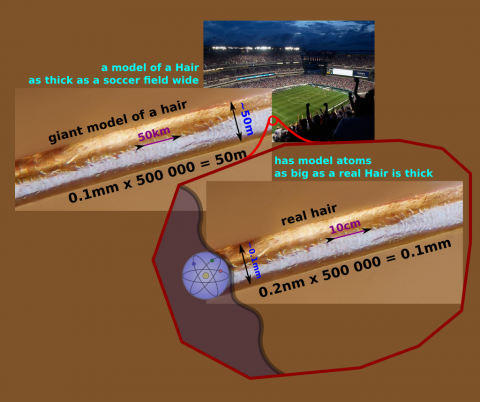Intuitive feel
This is an introduction to the character of robotic work in the nanocosm.
It should deliver some intuitive feeling of how things work down there.

Contents
How big is an atom?
Atoms are quite small but they are not as ridiculously small as people usually say. If a hair (0.1mm) would be the width of a soccer field (~60m) an atom would be roughly the size of a hair. Carbon is about 0.2nm or 2Å in size that makes roughly five atoms per nanometer. When hierarchically building up building structures one can quickly fill up this size gap.
Just for comparison: Relative distances in the other (astronomic) direction are vastly greater. If the planetary orbit of our outermost planet Neptune (which can technically be reached in years) where the size of a hair the nearest stars would lie beyond ~1km and the milkiway would be ~1000km thick at our location. The next galaxies would start at the diameter of our sun ~1000000km then still follows the unimaginable size of intergalactic voids, the observable universe and the universe extrapolated to our "now" of which we now little by now.
[Todo: add existing image]
How does it feel if you grab two atoms and rub them against each other?
First I should note that trying this out for real is actually possible for quite a while now (as unbelievable as it may sound). To feel atoms you grab the end of a robot (you shake hands with it). A tiny needle with a single atom at the tip is then made to move exactly like your hand just on a lot smaller scale. When the topmost atom on the needle tip starts to touch an atom on a surface the robot arm pushes back just as the surface pushes back on the needle albeit with a magnified force big enough for you to conveniently feel it. This is called force feedback common a common thing in car racing games. ...
What happens when you let go of a building block?
Let's consider an somewhat unusual fall experiment. A small gripper let go of a building block. Simple? See if you answer right.
Scaling laws
They describe what changes when one goes down the scale. E.g. that magnetic motors become weak but electrostatic ones strong. More details can be found at the scaling laws main page.
The feel of AP Products
AP products though robotic and gemstone like in the nanocosm are not necessarily cold hard and robot like to the human senses. Emulated elasticity can create any form imaginable with gradients from soft to hard. It isn't an easy to attain property but it is an highly desirable one and will emerge at some point.
Bonding energies - Tensile strengths - Stiffnesses
[Todo: Add table - make it visualizable for covalent bonds and VdW bonds]
[Todo: show surface area thats VdW ashesion is energetically equivalent to one covalent bond - related: Form locking]
Brownian motion in nanorobotics
- Envelope of throwing trajectories with same speed
- Throwing trajectories with various speed in same direction
Further
- acceleration limits
- jumping building blocks
